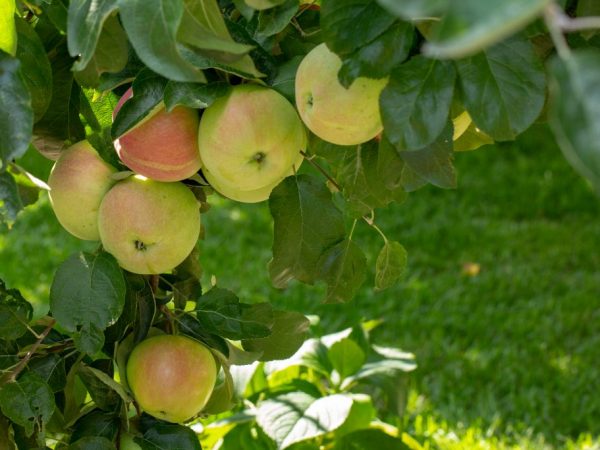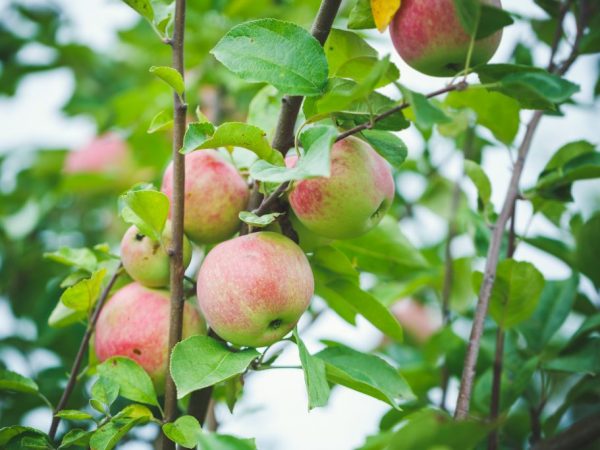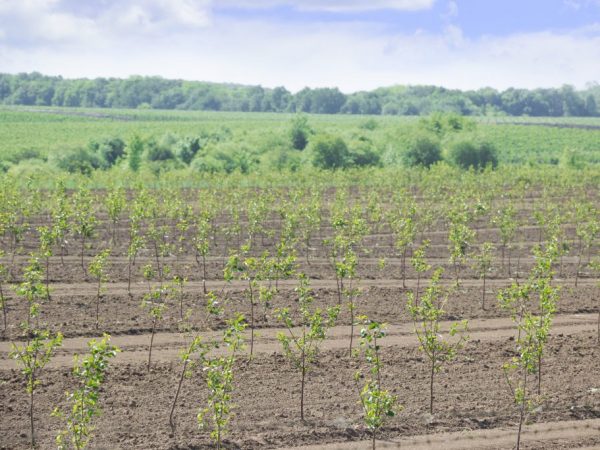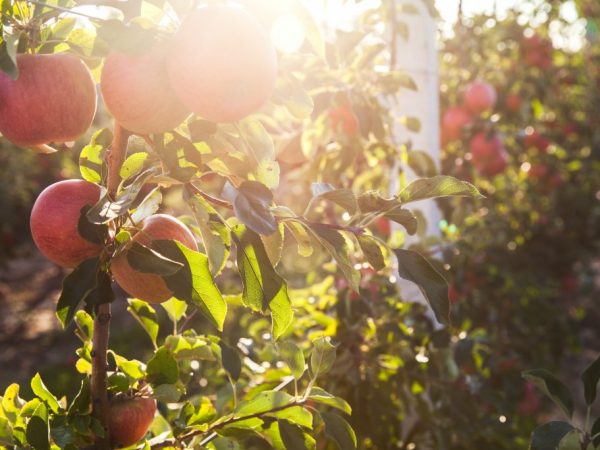Apple variety Snowdrop
Apple tree Snowdrop is a wonderful product of the joint work of scientists-breeders of the South Ural Research Institute of Fruit and Vegetable Growing V. Putyatin, N. Mazunina, M. Mazunin.
- Variety characteristic
- Description of the tree and fruit
- Taste characteristics of fruits
- Self-fertility
- Frequency of fruiting
- Yield
- Winter hardiness
- Pest and disease resistance
- Growing regions
- Planting an apple tree
- Timing
- Site preparation
- Pit preparation
- Care
- Features of ripening and fruiting
- Harvesting and storage
- Varieties of apple trees
- Gardeners reviews
- Advantages of the variety
- disadvantages

Apple variety Snowdrop
During the breeding of this bonsai, the method of free pollination was used using the genetic material of the Vydubetskaya plakuchaya variety. In addition to excellent yield indicators, the tree is valued by all gardeners for its visual and decorative appearance and unpretentiousness in growing and maintaining.
Among the people, this undersized tree received the nickname "Mazuni dwarf" by the name of one of its creators, which already serves as proof of the popular recognition of the value of its positive qualities.
Variety characteristic
The apple tree Snowdrop is very fond of gardeners for its many advantages.
Fruits are inherent in versatility - they are consumed both fresh and dried (dried fruits), and after cooking (jam, juice, compote, jam, jam, marshmallow, etc.).
Breeders in their work use its genetic material to create other dwarf trees.
Description of the tree and fruit
Snowdrop is a dwarf apple tree with a horizontally spreading and very spreading crown.
It grows no more than 1.5-2 m in height with a seed stock and up to 1-1.5 m for a clonal stock.
- Stale tree. Young branches grow horizontally in breadth or droop downward.
- The color of the bark on the trunk and main branches is light brown, in young branches it is greenish-brown.
- During the fruiting period, the branches bend under the weight of numerous apples, during this period they need props or garters.
- The leaves are rather large, oval, pubescent with a small-town edged, dark greenish tint.
- Apples are slightly larger than average. They have indistinct ribs and numerous light subcutaneous punctures.
- The average weight of one apple is in the range of 150-170 g. As a result of enhanced agricultural technology, the maximum weight of one fruit can reach 300 g.
- The skin is pale yellow, glossy and smooth; a slight blush can be seen over the entire surface.
- The peduncle is medium, strong, erect.
- The pulp is fine-grained, very juicy, sweet and sour in taste, dense, pure white shade.
Taste characteristics of fruits
Apples have a mild but pronounced aroma and a refreshing sweet and sour taste.
Self-fertility
There is no such quality as independent pollination. To obtain ovaries, planting of other winter or early winter pollinating apple trees is required.
Pollinating varieties
Optimal apple trees for pollination: Carpet, Land, Sokolovskoe. But other winter varieties can also be used as pollinators.
The frequency of fruiting

Young trees bear fruit every year
The beginning of fruiting falls on the 3rd or 4th year after the rootstock. Young and mature trees produce fruit every year. With increasing age and aging of trees, fruit formation becomes periodic.
Yield
Average yields are approximately 75-95 kg of apples per tree. This is considered an excellent indicator for a dwarf fruit species.
Winter hardiness
Winter hardiness is so great that the tree can withstand frosts down to -40 ° C. At even lower (extreme) winter temperatures, the tree freezes up, but has the ability to quickly restore green mass.
An apple tree is able to restore a frozen crown in just 1 or 2 years, and then again continue to bear abundant fruits.
Pest and disease resistance
The tree has average resistance to major diseases and pests of fruit trees. Very high resistance to scab disease. As a prophylaxis against diseases and pests, measures that are standard for all fruit trees are used.
Growing regions
The dwarf fruit tree was specially created for growing in the cold climates of the Urals and Western Siberia. But at the moment it has already become ubiquitous in the rest of the country, both northern and southern.
Planting an apple tree
If you dream of growing a Snowdrop apple tree in your garden, you need to study the description of the variety, as well as familiarize yourself with the rules of planting and subsequent care.
Timing
Planting seedlings can be carried out in the spring - when the soil warms up enough to start seasonal work. And it can be carried out in early autumn, while it is warm and the first frost has not yet come.
If the trees are planted in the fall, then the young seedlings will need to be sheltered from frost by mulching.
Site preparation

Trees need sunlight
The landing site should be open and well-lit (preferably east or south-east).
In shaded areas, the seedling will also grow, but the growth and fruit rate of the tree may be worse.
When choosing, the level of groundwater suitable to the surface is also important: if it is too high, then you should choose another place or fill in an additional layer of earth in the form of a high ridge, and then plant it.
The tree is not demanding for any particular type and composition of the soil. The only exception is clay soil, too heavy for the not very large root system of a bonsai.
The characteristics of heavy soil can be slightly improved by adding humus, compost mass, peat, sand, expanded clay or sawdust to it. The optimal soil will be land with slightly acidic or neutral acidity and medium fertility.
Pit preparation
- To plant a seedling, you will need a hole with a diameter of approximately 40 cm (depth and width).
- Organic fertilizer (ash, dry rotted manure, peat) is applied to the bottom of the pit.
- Next, a layer of earth is poured in the form of a small hill, on which a seedling is placed vertically with roots neatly spread along the hill.
- The hole must be buried in such a way that the root collar of the seedling is not buried, but remains at the same level or slightly above the ground surface.
The distance between the seedlings in the ridge should be at least 2-3 m, and between the ridges - at least 4 m. The newly planted tree should be watered at the rate of 2-3 buckets of water per seedling.
Care
- Watering the Snowdrop should be done regularly, but in moderation. The tree does not like excessive moisture, but it can perfectly tolerate dry periods. True, in the hot summer period, water should be more abundant, as well as shade the crown and fruits from the scalding ultraviolet rays with a special stretch mesh.
- Formation of the crown of the tree and sanitary pruning (removal of dead wood and excess branches thickening the crown) is carried out every spring. This simple but necessary procedure is the key to a good harvest and a preventive measure against the appearance of pests and diseases. Shaping and pruning contributes to the uniform growth of branches of each order, as well as the correct distribution of the future crop over them.
- Thinning of the ovaries. After the formation of fruits, the middle ovary should be removed from each bunch, leaving no more than 5 fruits in the bunch. This will help save the tree from overload in the future, as well as preserve the taste of the remaining apples.
- Fertilization. Spring feeding with organic matter (infusion of rotted mullein, ash, chicken droppings, etc.) under the root, as well as periodic foliar feeding with potassium sulfate and urea solutions by spraying on the leaf (crown) of the tree lead to active growth and excellent results in tree yield.
- The soil under the tree should be periodically loosened, growing weeds should be removed, the soil should be mulched with sawdust, humus, peat, etc. All this will not only improve the quality of the soil, but also serve as additional protection from winter frosts.
Features of ripening and fruiting
According to the description, its early maturity becomes an exceptional feature of the variety. The active fruit formation of young trees begins in just 3 or 4 years.
The snowdrop does not pollinate itself, therefore, to start fruiting, it needs another apple tree of the early winter type, which must be planted next to it in the garden bed. After that, it will bear fruit abundantly every year, and the ovaries are formed on both young and old shoots.
The fruits reach maturity and are ready to harvest by September-October. In the southern regions, harvesting begins at the beginning of September, and in the northern regions, due to the colder climate, the ripening of fruits is slightly delayed, and harvesting can begin only by the end of October.
Harvesting and storage

Harvesting must be done in dry weather
The shelf life of apples is approximately 4 months. For the best preservation of the harvest, the fruits must not only be stored correctly, but also correctly harvested from trees.
How to harvest the fruit:
- Harvest in dry and sunny weather. If the weather is rainy and damp, then the fruits must be carefully dried after harvesting.
- Grab the fruit on the branch with your palm, lift it and roll it along with the stem around its axis. The stalk remaining on the apple should not be removed, but the leaves can be torn off.
How to store fruits:
- Prepare wide, low-sided wooden crates for winter storage. The boxes must be dry and clean.
- Look carefully at the apples you have harvested. For winter storage, choose exclusively whole (no physical damage) and healthy (no signs of disease) apples.
- Wrap the apples in paper (newspaper). Only put fruits in boxes in one layer, as it is not recommended to stack them on top of each other.
- Place the boxes with the fruits in them in a cool, dry and dark place.
Varieties of apple trees
The tree is considered an early winter dwarf, varieties of which become the varieties Granny Smith, Sinap Orlovsky, Moscow Jubilee, Lobo, Winter Beauty.
Gardeners reviews
This amazing bonsai, completely covered with apples during the period of fruit formation, has won the well-deserved popularity of gardeners from all regions of the country. It never ceases to amaze with its vitality, unpretentiousness, beauty and, of course, the excellent taste of ripe and juicy apples!
Advantages of the variety
- Early maturity.
- Frost resistance.
- Drought resistance.
- Recovery ability.
- Almost complete undemanding to the soil.
- Decorative appearance.
- Dwarf compact size.
disadvantages
- Self-infertility.
- Deterioration of taste by the end of the shelf life.

